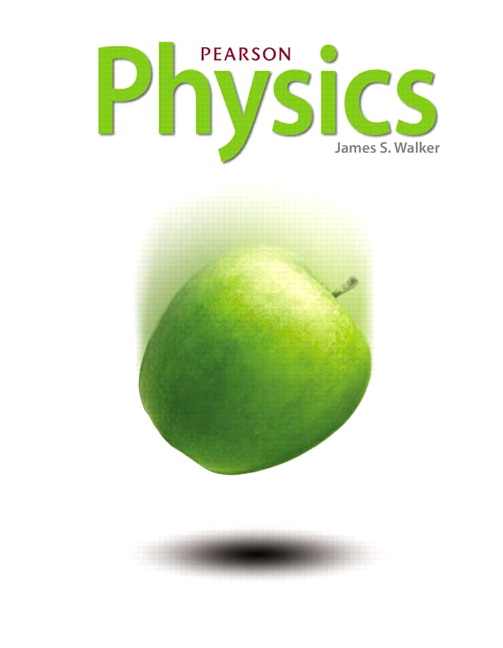
All Solutions
Page 703: Standardized Test Prep
The separation between the charges is $r= (6 -1):m = 5:m$.
So the magnitude of the force on $q_2$ due to $q_1$ is
$F_{21} = k dfrac{|q_1| |q_2|}{r^2}$ with $k = 8.99 times 10^9 : N.m^2/C^2$.
Substituting the values of charges and separation,
$F_{21} = dfrac{8.99 times 10^9 times 3 times 10^{-6} times 4 times 10^{-6}}{5^2} = dfrac{8.99 times 3 times 4}{5^2} times 10^{-3} = 0.0043:N$
Since the charges are of opposite kind the force is attractive. So it acts towards the left.
The magnitude of the force on the proton due to the charge $q_1 = +3:mu C$ is
$F_1 = k dfrac{|Q| |q_1|}{d^2}$
where $k = 8.99 times 10^9:N.m^2/C^2$ and $d = (3 -1):m = 2:m$
$F_1 = dfrac{8.99 times 10^9 times 1.6 times 10^{-19} times 3 times 10^{-6}}{2^2} = dfrac{8.99 times 1.6 times 3}{4} times 10^{-16}$
$F_1 = 10.8 times 10^{-16}:N$
Both charges are of same kind and hence the force is repulsive. It acts towards the right.
$vec{F}_1 = 10.8 times 10^{-16} :hat{x}$
The magnitude of the force on the proton due to the charge $q_2 = -4:mu C$ is
$F_2 = k dfrac{|Q| |q_2|}{d^2}$
Substituting the value,
$F_2 = dfrac{8.99 times 10^9 times 1.6 times 10^{-19} times 4 times 10^{-6}}{(6-3)^2}$
$F_2 = dfrac{8.99 times 1.6 times 4}{3^2} times 10^{-16} = 6.4 times 10^{-16}:N$
Both charges are of opposite kind and hence the force is attractive. It also acts towards the right.
$vec{F}_2 = 6.4 times 10^{-16} :hat{x}$
Now the total force on the proton is
$vec{F} = vec{F}_1 + vec{F}_2 = 10.8 times 10^{-16}:hat{x} + 6.4 times 10^{-16}:hat{x} = 17.2 times 10^{-16}:hat{x} = 1.72 times 10^{-15} :hat{x}$
– If the given charge is placed at some point between the two charges, the two forces acting on this charge will point in the same direction and thus there will be no cancellation.
– If the given charge is placed at some point on either side of the two charges, the two forces acting on it will be directed in opposite directions.
But in order for the two forces to balance, we need to place the given charge closer to the charge of less magnitude (+3-$mu$C). Thus the +2-$mu$C charge should be placed to the left of $x = 1$ m (the location of the +3-$mu$C charge), which is the choice $textbf{(B)}$.
textbf{(B)}
$$
$F = k dfrac{qQ}{d^2}$
Now if charge $Q$ is changed to $Q’$ and the distance is changed to $d’$ then the force on $q$ is given by
$F’ = kdfrac{qQ’}{d’^2}$
If $Q’=2Q$ and $d’=2d$ then we have
$F’ = k dfrac{2qQ}{(2d)^2} = k dfrac{{2} qQ}{{4}d^2} = k dfrac{qQ}{2d^2} = dfrac{F}{2}$
So the force decreases by a factor 2.
The magnitude of the force it exerts on another point charge of $+5:mu C$ placed at $x=8:m$ is given by
$F = dfrac{8.99 times 10^9 times 10 times 10^{-6} times 5 times 10^{-6}}{6^2}$
$F = dfrac{8.99 times 10 times 5}{36} times 10^9 times 10^{-6} times 10^{-6} = 0.0125:N$
Since both charges are of same kind the force is repulsive and it acts to the right.
Charge of the electron is $-1.6 times 10^{-19}:C$.
The magnitude of the force acting on the proton, when it is at a distance of $1:m$ from the electron, is given by
$F = dfrac{8.99 times 10^9 times 1.6 times 10^{-19} times 1.6 times 10^{-19} }{1^2}$
$= 8.99 times 1.6 times 1.6 times 10^9 times 10^{-19} times 10^{-19}$
$F=23.01 times 10^{-29}:N$
From Newton’s second law of motion, the acceleration of the proton is given by
$a = dfrac{F}{m_p}$
where $m_p$ is the mass of the proton and its value is $1.673 times 10^{-27}:kg$.
$a = dfrac{23.01 times 10^{-29}}{1.673 times 10^{-27}} = dfrac{23.01}{1.673} times 10^{-29} times 10^{27} = 0.14:m/s^2$
$a = dfrac{F}{m_e}$
The magnitude of the force $F$ and the mass ($m_e$) of the electron is 1836 times smaller than the mass of the proton.
So the initial acceleration of the electron is larger than that of the proton.
$textbf{(b)}$ The total charge on the meterstick, before, during, and after the rod is brought near one end is unchanged and equal to $zero$. This is because the meterstick is uncharged in the first place and according to the conservation of electric charge, the total charge on the meterstick remains unchanged (zero). However, the distribution of the equally positive and negative charges, comprising the neutral meterstick, changes as the rod is being brought near its end; The negative charge on the rod attracts the positive charge of the meterstick toward the near end and repels the negative charge away, toward the further end.
Haven't found what you were looking for?
Search for samples, answers to your questions and flashcards

